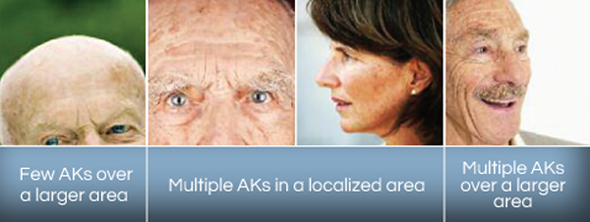

Levulan PDT is contraindicated in patients with cutaneous photosensitivity at wavelengths of 400-450 nm, porphyria, or known allergies to porphyrins, and in patients with known sensitivity to any of the components of the Levulan Kerastick for Topical Solution.
Levulan® Kerastick® has not been tested on patients with inherited or acquired coagulation defects. It is possible that concomitant use of other known photosensitizing agents might increase the photosensitivity reaction of actinic keratoses treated with the Levulan® Kerastick®.
Application of Levulan® Kerastick® should involve either scalp or face lesions, but not both simultaneously. Levulan® Kerastick® should not be applied to the periorbital area or allowed to contact ocular or mucosal surfaces. Excessive irritation may be experienced if this product is applied under occulsion.
Indication
Levulan® Kerastick® (aminolevulinic acid HCl) for Topical Solution, 20% plus blue light illumination using the BLU-U® Blue Light Photodynamic Therapy Illuminator is indicated for the treatment of minimally to moderately thick actinic keratoses of the face or scalp.
Important Risk Information
Application of Levulan® Kerastick® should involve either scalp or face lesions, but not both simultaneously. Levulan® Kerastick® should not be applied to the periorbital area or allowed to contact ocular or mucosal surfaces. Excessive irritation may be experienced if this product is applied under occlusion.
Contraindicated in patients with cutaneous photosensitivity at wavelengths of 400-450 nm, porphyria, or known allergies to porphyrins, and in patients with known sensitivity to any of the components of the Levulan Kerastick for Topical Solution.
Levulan® Kerastick® has not been tested on patients with inherited or acquired coagulation defects. It is possible that concomitant use of other known photosensitizing agents might increase the photosensitivity reaction of actinic keratoses treated with the Levulan® Kerastick®.
Patients should avoid exposure of the photosensitive treatment sites to sunlight or prolonged or intense light for at least 40 hours after application of the Levulan Kerastick Topical Solution. Exposure may result in a stinging and/or burning sensation and may cause erythema or edema of the lesions. Patients should protect treated lesions from the sun by wearing a wide-brimmed hat or similar head covering of light-opaque material. Sunscreens will not protect against photosensitivity reactions caused by visible light.
Most common adverse events including stinging and/or burning, itching, erythema, and edema were observed in all clinical studies. Severe stinging and/or burning at one or more lesions being treated was reported by at least 50% of patients at some time during treatment. However, less than 3% of patients discontinued light treatment due to stinging and/or burning.
During light treatment, both patients and medical personnel should be provided with blue blocking protective eyewear, as specified in the BLU-U operating instructions to minimize ocular exposure.
For additional important safety information, please see full prescribing information.
- Enhancing Prescription Medicine Adherence: A National Action Plan. National Council on Patient Information and Education. August 2007.
- Gupta, G, et al. Adherence to topical dermatological therapy: lessons from oral drug treatment. Br J Dermatol. 2009;161:221-227.




